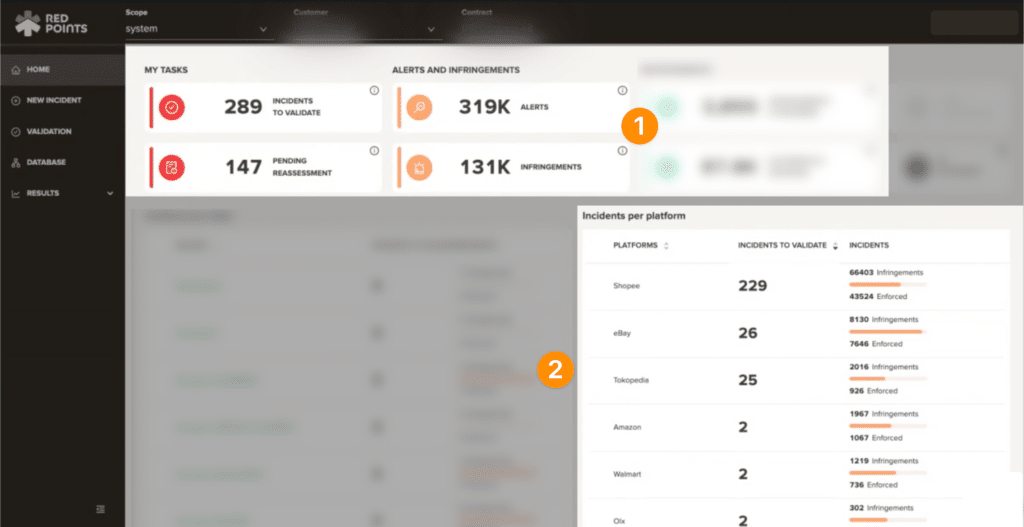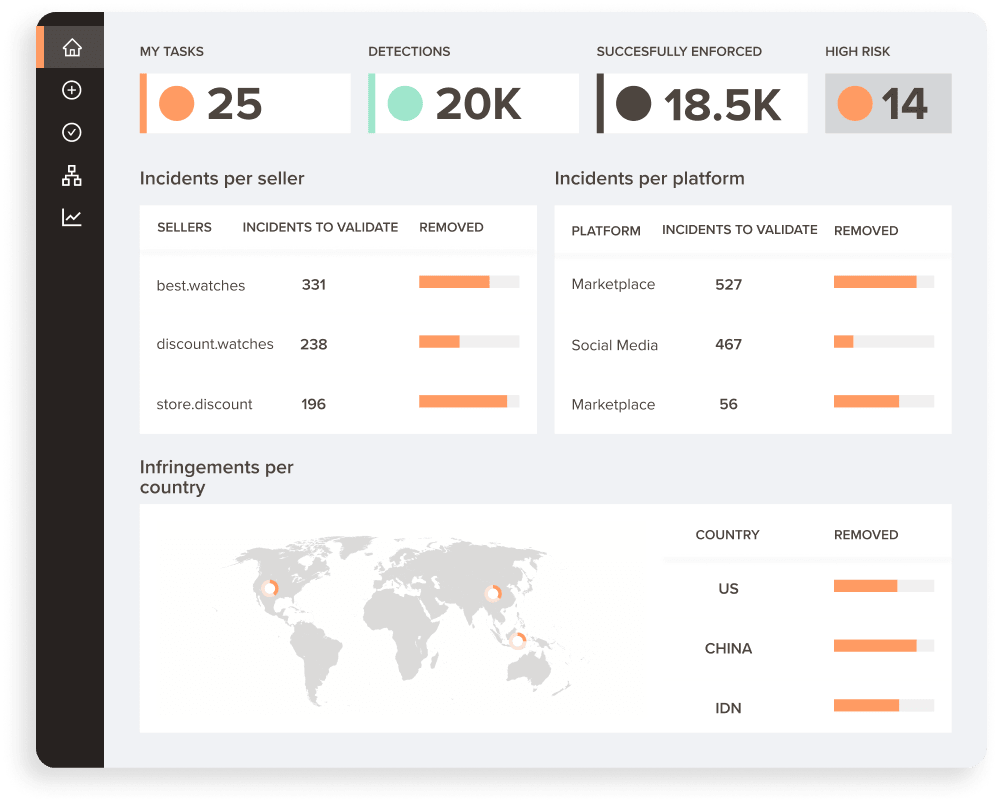Imagine this: you’ve poured years into building a trusted brand—designing your products, crafting your story, and earning customer loyalty.
Then, out of nowhere, a fake website emerges, copying everything from your logos to your product descriptions, even using your employees’ photos.
Worse still, they’re running fake ads on Google or social media like Instagram to sell your products at a fraction of the price. Customers, duped into thinking the site is yours, pay for goods that never arrive and flood your inbox with complaints.
This isn’t just an inconvenience—it’s a full-scale assault on your reputation and your bottom line. And this isn’t an isolated problem—our data shows that reported fake websites for our clients have surged by 161% since 2022, with over half using popular web hosting and proxy services to mask their operations.
At this point, many businesses come to us asking for help. They’ve tried everything on their own—filing complaints with hosting providers, reporting fraud to Google, contacting state authorities—but the fake site remains.
Does this sound familiar? If this frustrating cycle leaves you wondering: What do you do when nobody seems to care?
In this blog, we’ll show you exactly how to take decisive action to successfully take down fake websites like this. Whether you’re battling a scammer’s copycat tactics or protecting your customers from being duped, this guide will provide actionable steps to reclaim control and safeguard your brand.
Let’s turn frustration into action.
4 Ways to report and take down a fake website
1. Send cease and desist letters
Once you find a fake website, sending a cease and desist letter to the site admin or domain registrant is the first step to take when you report a fake website. A domain registrant search service like ICANN should be able to pull up this information on a fake website.
But most registrants won’t respond to your letter.
In this case, you should also send a C&D letter to the CMS platform the fake domain runs on. Popular CMS platforms like Wix, Squarespace, Shopify, etc., have guides on this.
If you still don’t get a response, try these:
- Report the fake website to the server host via a C&D letter.
- Send a notification to the domain registrar. Large registrars like GoDaddy, NameCheap, etc., may be able to help.
- Scammers could register a fake site with your name, making it difficult for you. If that’s the case, contact and report to ICANN.
- If the fake website is selling counterfeits of your products, contact and report the fake website to the payment processing company they’re using. Payment processors like Visa, PayPal, etc., have fraud departments that can help with taking a fake website down.
2. Report the fake website to Google
Google can also help.
If a fake website is involved with criminal activities like phishing, report the domain to Google’s safe browsing team to get it de-indexed and stopped from coming up in search results.
It takes four steps to report a fake website to Google:
- Visit safebrowsing.google.com,
- Add the fake site’s URL,
- Provide additional information (to expedite action),
- Hit submit:
[source]
Reporting scam websites via the steps above is free.
But what if you’re dealing with higher volumes of spoof websites? Worse, what if even after taking one down, another three to five pop up? And more importantly, what if you don’t have the time to monitor the various ways scammers are trying to spoof your website?
Again, that’s why over 1,300 brands turn to Red Points:
[Red Points Review on G2]
3. Leverage technology for automated takedowns
Red Points’ robust website takedown solution and dedicated Customer Success Manager assigned to each customer do 97% of the work on reporting and taking down fake and scam websites.
Once you log in, you’ll, among other things, see two crucial data summaries relevant to taking down fake websites at scale:
- Critical fake website incidents to evaluate from thousands of possible infringements automatically scoured from the web.
- The platforms scammers are using to fake your website:

Here’s how Red Points helps report and take down a fake website.
At Red Points, we empower brands to protect what matters most—trust, integrity, and value. Through AI-driven innovation, we relentlessly combat counterfeits, scams, and piracy. Our 10-year trained suit of AI tools is powered by the world’s largest brand protection dataset, analyzing 2.7 billion data points every month.
The platform works 24/7 in a 3-step funnel:
- Monitoring & Detection,
- Evaluation & Prioritization,
- Auto-takedowns (per your preference).
Monitoring & Detection
Based on the documentation given when signing up e.g. trademarks, patents, and copyrights, Red Points monitors the global web for all infringements directly or indirectly related to your brand. That’s why as a first step, it’s critical for your brand to have all your intellectual property rights registered before leveraging Red Points’ platform.
The team then defines automation rules to facilitate the process of having any fake website removed online. Our platform learns over time based on users making the results more accurate over time.
That’s how it auto-detects fake websites:
Evaluation & Prioritization
In the example above, there were over 36,000 possible copyright infringements. That’s too much for anyone to deal with at once.
And you don’t need to.
The advanced machine learning algorithm built into Red Points does the heavy lifting of grouping the incidents you should evaluate (1). It also groups the once perceived to be of high risk (2):
Automated Takedown Requests
Red Points works in the background to automate the takedown process for scam websites based on conditions approved by you. After sending a takedown request, one common frustration businesses face is the need to continuously check on the status and respond to potential counter-notices. Red Points solves this challenge by automating not only the takedown requests but also the follow-up process. Our platform tracks the status of each request in real-time, ensuring no action is left incomplete, and proactively handles counter-notices when they arise.
Ultimately, our platform handles the entire enforcement process while providing transparency. This means you can see reports of how many fake websites got taken down within a period, as well as the economic value (i.e., revenue leaks blocked and recovered):
One more thing.
Brands who come for the efficiency of Red Points’ in-built detection AI end up staying for their dedicated Account Manager. You don’t just have to take our word for it:
[Red Points Review on G2]
4. Report fake ads and websites simultaneously
Fake websites rarely exist on their own. They are often paired with ad campaigns on social media platforms to drive traffic. These ads can copy your brand’s content and logo to lure unsuspecting customers even without using your keywords in the ad copy.
This is the problem KEEN Footwear (one of our clients) ran into. If you are not familiar with them, KEEN has been offering American-built footwear since 2003.
The company came to us when they started noticing ads for fake sites that looked just like their own advertisements. These ads had KEEN’s logo, font, and imagery while advertising unrealistic deals like 90% off products.
Many ads went to multi-brand web shops that advertised KEEN alongside other footwear companies like Adidas and Nike. This added credibility from the customer’s point of view.
When you’re dealing with multiple types of infringement, you have to take a multi-pronged approach. This is where Red Points’ wide enforcement coverage comes into play.
The platform can take down ads in addition to fake websites at the same time. In this way, you hit the scammers on multiple fronts at once.
Through Red Points’ technology, KEEN was able to cover 1,000 domains and enforce against $35.6 million worth of counterfeit products online.
Most common types of fake websites Red Points detects
Now that you know how to take down a fake website, here are some additional types of fake wesbites you should look at when protecting your brand.
Our team has seen fraudulent websites that exist for phishing, scams, ecommerce fraud, counterfeit products, and more.
Here are the most common types of fake websites our systems detect:
- Phishing websites: These sites mimic legitimate ones to deceive users into entering sensitive information such as passwords or credit card numbers. They often replicate the design of well-known banks, online services, or retailers to trick users.
- Scam websites: These websites promise unrealistic rewards or products at very low prices to swindle money or personal information. They may advertise fake lotteries, incredible investment opportunities, or ‘free’ products that require payment of ‘shipping fees’.
- Fraudulent ecommerce sites: Set up to sell non-existent products or counterfeit goods, these fake websites take consumers’ money but either deliver nothing or send fake or substandard products.
- Malware distribution sites: These appear legitimate but aim to infect visitors’ devices with malware, leading to data theft, ransomware attacks, or unauthorized use of computing resources.
- Fake online marketplaces: Resembling platforms like eBay or Amazon, these marketplaces are set up for fraudulent transactions, often selling non-existent, stolen, or counterfeit items.
- Counterfeit product websites: Focused on selling fake versions of popular or luxury goods, these sites often lure customers with attractively low prices but provide poor quality counterfeits.
Each type of fake website is designed to exploit different vulnerabilities, whether it’s a user’s trust, desire for a good deal, or investment goals.
Advancements in AI and machine learning mean that scammers are now leveraging generative AI and machine learning algorithms to create more convincing fake websites that can bypass traditional detection methods, making it harder for brands to identify and take down these fake sites. By identifying and addressing these varied threats, you can safeguard your brand’s integrity, revenue, and customer trust.
Lesser-known tactics used by fake websites: Insights from Red Points
Fake websites are designed to deceive, but the tactics scammers use often follow predictable patterns. At Red Points, after years of helping brands enforce their rights and shut down fake sites, we’ve identified the telltale signs these scammers rely on repeatedly. By understanding these patterns, you can better detect and combat these threats before they harm your brand.
From freshly registered domain names to stolen imagery and broken social media links, here are the less known strategies fake site operators use:
- New domain names: Fake sites use freshly-registered domain names that are days or months old.
- Registrar patterns: Fake sites will often use the same registrar over and over. This might be because other registrars took their sites down after an enforcement request.
- Predictable domain extensions: Many fake sites use .online and .shop extensions in addition to .com.
- Stolen imagery: Scammers download brand photos or take screenshots to create sites and ads.
- Poor typists: Fake site owners aren’t the best writers, and you’ll find plenty of grammatical errors and inconsistencies on their sites.
- Broken social media links: A fake website might have buttons to visit the brand’s social media pages, but these won’t work. It could also have broken links to brand profiles in the content.
- Content delivery networks (CDNs): The scammer may use proxy servers through their hosting provider to keep their IP address anonymous.
What’s Next?
Fake sites can decrease your brand’s revenue and hurt your reputation, but you aren’t powerless to fight back. If you have a small issue, you may want to manually send C&D letters and report pages to Google. But manual enforcement can turn into a game of whack-a-mole as fake sites and ad campaigns come back.
Red Points’ automated enforcement platform can uncover new threats as they emerge and help you get ahead of scammers. Click below to book a quick demo and see Red Points in action with your brand.


